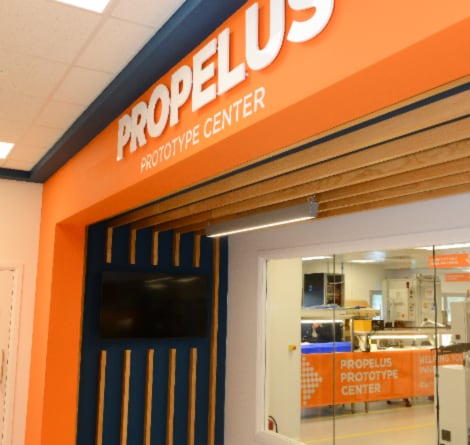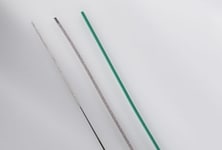For more details and information on our Medical Coils products and capabilities, visit our product catalog on te.com or download our brochure. You can also connect with our experts to learn more, get samples and design support.
Design & Customization
Q: What coil geometries can you support (e.g., helical, solenoid, toroidal)?
A: We can manufacture helical, solenoidal, and custom-shaped coils depending on the application. We also support complex geometries such as multi-layer windings or bifilar windings when needed for redundancy or field uniformity.
Q: Can you customize wire diameter, pitch, turn count, or length?
A: Yes, our coil winding process is highly configurable. We support wire diameters from ~0.0127 mm (0.0005”) up to ~0.2 mm (0.008”), with precise control over turn count, pitch, and coil length. We work closely with you to match electrical and mechanical specs exactly.
Q: How small can you make the coil (inner/outer diameter, length)?
A: We can produce micro coils with outer diameters under 0.5 mm, depending on the material and application. These are often used in neurovascular or
intravascular devices.
Q: Can you integrate the coil into a catheter shaft, hypotube, or guidewire
assembly?
A: Yes, we frequently integrate coils into catheter shafts, hypotubes, and hybrid
subassemblies with strain reliefs, terminations, and connectors. We’re also experienced in overmolding and joining to other components.
Materials & Coatings
Q: What wire materials are available (e.g., MP35N, Nitinol, Platinum-Iridium)?
A: We typically work with MP35N, stainless steel, platinum-iridium, and Nitinol,
among others. Material selection depends on your electrical conductivity,
fatigue, and biocompatibility requirements.
Q: Are the materials MRI-safe or radiopaque?
A: Yes — for MRI compatibility, we often use non-ferromagnetic alloys like
platinum-iridium. For radiopacity, materials such as gold and platinum are
available.
Q: What coating or insulation options do you offer (e.g., Parylene, PTFE, polyimide)?
A: We offer polyimide, Parylene, PTFE, and other thin-film coatings. Insulation
type and thickness are tailored to electrical requirements and processing
needs.
Q: Is the coil biocompatible or implant-grade?
A: Yes, we select medical-grade materials and coatings that comply with ISO 10993 and are suitable for contact with bodily fluids or tissues, including
implantable-grade materials.
Performance & Application Fit
Q: How do your coils perform under repeated flexing or torque?
A: We test for mechanical durability under repeated bending and torsion. Our coils are designed to maintain electrical performance even under dynamic loading — especially important in steerable or active catheters.
Q: Can they transmit electrical signals, mechanical motion, or both?
A: Both. We support low-resistance winding for signal fidelity (e.g., in IVUS or
neurostimulation) as well as robust actuation coils for electromagnetic
movement or thermal activation.
Q: What frequency ranges or signal integrity can the coil support?
A: This depends on wire gauge, winding geometry, and insulation. We work with customers to model inductance, resistance, and self-resonance to meet specific signal performance targets — typically from kHz to low MHz ranges.
Q: What’s the pull strength / tensile strength of your bonded joints?
A: We design for high mechanical integrity. Our terminations and welds undergo pull testing per IPC and customer-specific protocols. We can support >5 lb pull strength depending on configuration.
Manufacturing & Quality
Q: Do you manufacture in a cleanroom environment?
A: Yes — we manufacture in ISO 7 and ISO 8 cleanroom environments where needed, particularly for implantable or interventional devices.
Q: What tolerances can you hold on dimensions and resistance?
A: Dimensional tolerances down to ±10 µm and electrical tolerances within ±5% resistance are common. Specific tolerances depend on coil size, wire type, and application.
Q: What kind of in-process inspection or quality control do you perform?
A: We use high-resolution vision systems, resistance checks, mechanical gauges, and optical comparators throughout the winding and finishing processes.
Q: Are your processes ISO 13485 certified or FDA audited?
A: Yes. TE Connectivity operates under ISO 13485:2016 and FDA-audited quality systems for medical manufacturing.
Integration & Supply
Q: Can you provide assembled subcomponents (e.g., coil + connector + strain relief)?
A: Yes — we can provide plug-and-play assemblies with electrical connections, strain reliefs, or integration into full catheter shafts, depending on your BOM.
Q: Do you support rapid prototyping?
A: Yes. We have fast-track engineering teams to support early-stage development and feasibility builds, with short lead times and iterative design feedback.
Q: What are your lead times for custom designs?
A: 2-3 weeks if RM is on hand
Q: Can you scale to volume production?
A: Absolutely. We support seamless transfer from prototyping to validated production, including tooling, process validation (IQ/OQ/PQ), and supply chain planning.
Regulatory & Documentation
Q: Can you provide traceability for materials and process steps?
A: Yes — we track raw materials, lot numbers, process steps, and inspection data. Full Device History Records (DHR) are available when required.
Q: Do you offer design history files, PPAP, or validation documentation?
A: We provide IQ/OQ/PQ protocols, FMEA inputs, PPAP documentation, and help with Design History Files (DHF) as part of regulated development processes.
Q: Have your coils been used in FDA- or CE-approved devices?
A: Yes. Our coils are already deployed in class II and class III devices across
neurovascular, cardiac rhythm management, and electrophysiology applications.

 e
e
 e
e
 e
e
 e
e

 e
e
 e
e
 e
e
